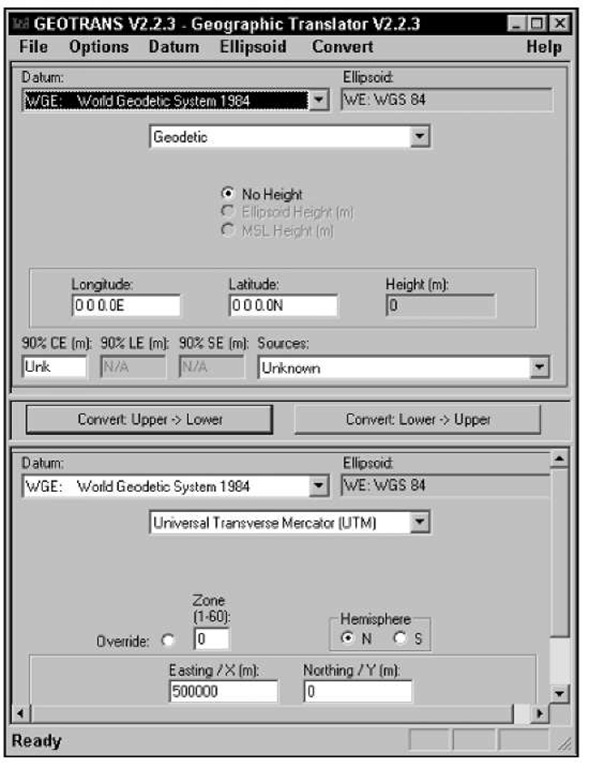Sometimes you might need to convert from one coordinate system to another. For example, you might have coordinates in latitude and longitude and a map with a UTM grid. Although there are many algorithms that you can use to convert data, let conversion utilities do all the work for you.
Using GeoTrans
GeoTrans is a popular, free Windows program developed by the Department of Defense (DoD). (GeoTrans is shown in Figure 11-6.) You can convert coordinates from many coordinate systems and datums. GeoTrans is available for download at http://earth-info.nima.mil/GandG/geotrans/geotrans.htm.
Follow these steps to convert between coordinate systems with GeoTrans:
1. Select the map datum used with the coordinates from the drop-down Datum list.
2. Select the coordinate system from the drop-down list below the datum.
Figure 11-6:
GeoTrans converts coordinates to another format.
Use Geodetic if you’re converting from latitude and longitude.
3. Enter the coordinates in the appropriate text boxes.
• If you’ve converting from latitude and longitude, enter the coordinates.
• If you’re converting from UTM, enter the Zone, Hemisphere, Northing, and Easting.
4. In the lower part of the window, select the datum and the coordinate system that you want to convert to.
5. Click the Convert Uppers Lower button.
The Graphical Locator
The Environmental Statistics Group at Montana State University hosts a very powerful online tool called the Graphical Locator. It’s a cross between a gazetteer and a coordinate utility converter. Some of its features are
- A map of the United States that shows coordinate information when you click a location. You can zoom in on regional and state maps. (The maps only show geographic features, not feature names.)
- Coordinate conversion utilities for latitude and longitude, UTM, and township, range, and section.
- Extensive information on selected locations, including latitude and longitude; township, range, and section; UTM; elevation; state and country; nearest named features and distances; and USGS 7.5 minute topographic map name.
The Graphical Locater is designed to work with locations within the United States. It’s fairly easy to use; its author, D.L. Gustafson, has extensive online documentation on the utility.
I use the Graphical Locator for quickly getting rough latitude and longitude coordinates of a location. Because there are no place names on the online maps, I consult a paper map with place names to zero in where I want to get location information if I’m unfamiliar with the terrain.
To check out the Graphical Locator, visit www.esg.montana.edu/gl.
Using online conversion utilities
If you don’t need to convert coordinates on a regular basis, you can save some hard drive space by using a Web-based coordinate conversion utility instead of installing GeoTrans. Most conversion sites are pretty straightforward to use; just enter the coordinate values that you want to convert and click a button. These sites are a few of the most popular:
For simple datum, latitude and longitude, and UTM coordinate conversions: http://jeeep.com/details/coord
For latitude and longitude, UTM, and Township and Range conversions: www.esg.montana.edu/gl
For advanced online and standalone conversion tools, visit the U.S. National Geodetic Survey: www.ngs.noaa.gov/TOOLS

